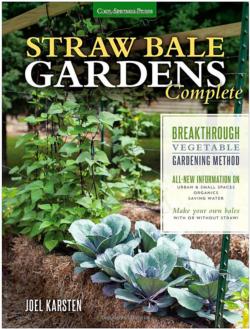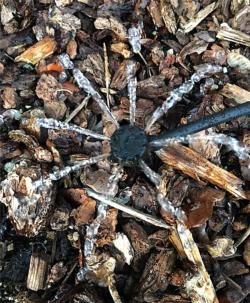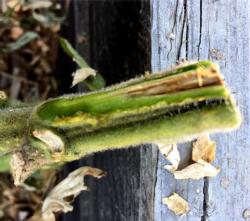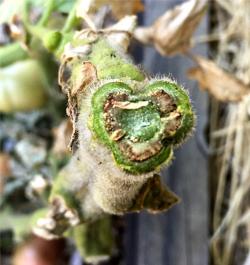Straw Bale Gardening Demonstration - 2017
Home » Horticulture Center » Vegetables » Straw Bale Gardening » 2017
Our fifth summer of straw bale vegetable gardening at the Fair Oaks Horticulture Center featured a second attempt at growing dwarf tomato varieties. Because most of the six dwarf tomatoes that we grew in 2016 had somehow contracted Fusarium wilt, as was confirmed by the State Lab (California Department of Food and Agriculture, Plant Health and Pest Prevention Services), we decided to grow the same six dwarf tomato varieties in 2017. The plan was to be as diligent as possible about sanitation and to be very careful not to introduce anything that could carry the Fusarium wilt fungal spores.Growing plants in straw bales has become popular over the past several years. We did our first straw bale gardening demonstration in 2013 based on the book Straw Bale Gardens (Joel Karsten, 2013, Cool Springs Press). In 2015 the book was revised (see photo) to address some of the questions the author received from readers.
Because our experiment in 2013 was so successful and generated a lot of interest from home gardeners, we followed up each year growing different vegetable varieties in straw bales:
- 2013 – pumpkins
- 2014 – small watermelons
- 2015 – melons and baby butternut squash, followed by carrots
- 2016 – dwarf tomatoes
- 2017 – dwarf tomatoes
For those who are unfamiliar with straw bale gardening, straw bales are not just the container, but also the growing media. As the straw inside the bale decomposes, it provides nutrients for the plants. What remains of the bales the following year can be used as vegetable garden mulch. The process starts with “conditioning” the straw bales, which causes the bales to compost internally so root growth can be supported.
For detailed information about setting up the bales, the conditioning process and the types of fertilizers that can be used during that process, as well as how to plant seeds and transplants into the bales, be sure to check out Garden Note #160.
Fertilizers used in conditioning. In 2017 we decided to do an experiment: organic fertilizers vs. chemical fertilizers to condition the bales. We took internal temperatures of the bales every day and came to the conclusion that there was not a whole lot of difference. We had assumed that the chemical fertilizer (high nitrogen lawn fertilizer) would heat up the bale quicker and hotter; however, the temperatures were very similar, with chemical fertilizer being hotter a couple of days and organic fertilizer being hotter most of the days.
Irrigation. The same irrigation method has been used each year since our first demonstration in 2013. It consists of a ½-inch supply line staked across the bales of straw, and ¼-inch tubing with shrubblers attached (see photo at right) punched into the ½-inch line. The bales were on the same irrigation timer as our container garden (daily for 5 minutes), and this schedule was more than adequate. Straw is very absorbent and has great water-holding capacity.
Fertilization. After the initial incorporation of organic fertilizers into the bales during the conditioning process, we supplemented with monthly fish emulsion applications, which is the same fertilization schedule that has been used each year since our first demonstration in 2013.
Since we were recreating the 2016 demonstration, we grew the same six dwarf tomato varieties that were part of the Dwarf Tomato Breeding Project (see 2016 straw bale gardening article for more information). Those varieties were:
- Summertime Green
- Rosella Purple
- Dwarf Sweet Sue
- Dwarf Arctic Rose
- Dwarf Russian Swirl
- Dwarf Mr. Snow
All of the varieties were grown in three bales of wheat straw, since it has been our experience that wheat straw holds together a little better than rice straw. The issue that arose in 2016 was that straw bales are supposed to be free of soil borne diseases, so it was assumed that the tomatoes were infected with Fusarium wilt, a soil borne fungus, through our lack of sanitation. It was possible that the fungus was accidentally introduced through compost that was used to heel in the transplants, or the fungus could have been spread via tools that carried the fungal spores. Sanitation was the prime objective in 2017, and every effort was made to not introduce any soil borne diseases into the bales or onto the plants.
All of the tomato plants were transplanted into the straw bales in mid-April, and by early June, Dwarf Russian Swirl and Dwarf Arctic Rose began exhibiting yellowing leaves. By early July, Rosella Purple and Dwarf Mr. Snow suddenly became almost totally wilted and brown (recent triple digit temperatures may have contributed to this, although irrigation seemed to be adequate). Dwarf Mr. Snow and Rosella Purple were removed from the straw bales, since both plants showed definite signs of Fusarium wilt: classic browning inside the cut stem and along the side of the stem when a shallow cut is made lengthwise along the stem (see photos below).
In early August, Dwarf Arctic Rose was removed from the straw bales and delivered to the State Lab for testing. At the suggestion of the Farm and Vegetable Crop Advisor for Yolo, Solano, and Sacramento Counties, the State Lab was asked to distinguish between Fusarium wilt (Fusarium oxysporum f. sp. lycopersici) and Fusarium crown and root rot (Fusarium oxysporum f. sp. lycopersici/radicus group) since apparently Fusarium crown and root rot can possibly be airborne. Around this same time, all of the seeds for the six tomato varieties were sent to the UC Davis Plant Pathology Lab for testing to see if the seeds contained the Fusarium pathogen (it is possible for Fusarium to be seed borne).
Results
None of the tomato seeds contained the Fusarium wilt pathogen, so the seeds did not appear to be the cause of the disease. The State Lab advised that Fusarium oxysporum was detected from roots and stems of the samples submitted for testing. The State Lab was not set up to differentiate between Fusarium wilt and Fusarium crown and root rot; however, they embraced our request and worked hard to set up the specific DNA-based tests that might help distinguish strains. After much work, the State Lab advised that gene sequencing confirmed it was closely related to Fusarium oxysporum f. sp. lycopersici/radicus group (Fusarium crown and root rot).
Conclusions
We definitely had problems growing tomatoes in straw bales in 2016 and 2017, and we still do not have an answer to the question of how a soil borne fungal disease like Fusarium can infect tomato plants that have never been grown in soil. The bottom line is that tomatoes will probably not be grown in straw bales anytime soon. Aside from the tomato disease issues, all of the previous demonstrations have been very successful, so we look forward to continuing to grow vegetables in straw bales…just not tomatoes.
So what is on tap for next year? Sweet potatoes, so stay tuned.
Resources
- Straw Bale Gardening (PDF) Garden Note 160, explains the basics for starting a straw bale garden in your yard.
- Return to our Straw Bales introduction for links to other years.
- There is also a free ANR publication on straw bale gardening (PDF).
- The book Straw Bale Gardens (Joel Karsten, Cool Springs Press) provides detailed information about setting up the straw bales and all aspects of straw bale gardening. The author's website also provides information and photographs that may be helpful if you would like to try growing vegetables in straw bales.







